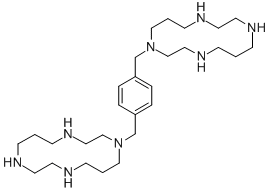All AbMole products are for research use only, cannot be used for human consumption.

Plerixafor is a bicyclam molecule that antagonizes the binding of the chemokine stromal cell-derived factor-1 (SDF-1) to its cognate receptor CXCR4. The CXCR4 alpha-chemokine receptor and one of its ligands, SDF-1, are important in hematopoietic stem cell homing to the bone marrow and in hematopoietic stem cell quiescence. CXCR-4 antagonist Plerixafor is one of the most efficient bone marrow stem cell mobilizers. Plerixafor inhibits SDF-1 mediated GTP-binding, SDF-1 mediated calcium flux and SDF-1 stimulated chemotaxis with IC50 of 27 nM, 572 nM and 51 nM, respectively. Plerixafor results in the rapid and reversible mobilization of hematopoietic stem cells into the peripheral circulation and is synergistic when combined with G-CSF.

J Nanobiotechnology. 2024 May 3;22(1):219.
Migrasomes from adipose derived stem cells enrich CXCL12 to recruit stem cells via CXCR4/RhoA for a positive feedback loop mediating soft tissue regeneration
Plerixafor (AMD3100) purchased from AbMole

Biomaterials. 2023 Oct 17.
The genetic background determines material-induced bone formation through the macrophage-osteoclast axis
Plerixafor (AMD3100) purchased from AbMole

Plast Reconstr Surg. 2023 Jan 9.
Early angiogenesis dependent CXCL12 attracts Adipose-derived stem cells to promote the repair of fat grafting in a mice model
Plerixafor (AMD3100) purchased from AbMole

Front Pharmacol. 2022 Feb 1;792293.
Deletion of Wild-type p53 Facilitates Bone Metastatic Function by Blocking the AIP4 Mediated Ligand-Induced Degradation of CXCR4
Plerixafor (AMD3100) purchased from AbMole
| Cell Experiment | |
|---|---|
| Cell lines | OS cell lines (LM8 and Dunn) |
| Preparation method | MTT assay. The effects of CXCL12 and AMD3100 on the survival of two OS cell lines (LM8 and Dunn) were assessed using a 3-(4,5-dimethylthiazol-2-yl)-2,5-diphenyltetrazolium bromide (MTT) assay. Cells were seeded in 96-well plates at 2×10^3/well in DMEM-h. After overnight growth, the cells were cultured for 7 days in FBS-free medium in the presence of 0 or 100 ng/ml CXCL12, 30 μM AMD3100 alone or 100 ng/ml CXCL12 with 10, 20 or 30 μM AMD3100. The FBS-free cells without 100 ng/ml CXCL12 or AMD3100 served as the control group. After the 7 day incubation, 20 μl MTT (5 mg/ml) was added into each well and incubated for 4 h at 37°C. Culture medium was removed and 150 μl dimethylsulfoxide was added. The optical density (OD) was then measured using a model ELx800 microplate reader at 490 nm. The cell viability was calculated using the equation: Cell viability (%) = (OD490nm of treatment/OD490nm of control) ×100%. |
| Concentrations | 30 μM |
| Incubation time | 7 days |
| Animal Experiment | |
|---|---|
| Animal models | orthotopic animal model of OS in Ten 4-week-old female C3H mice |
| Formulation | PBS |
| Dosages | 5 mg/kg every 2 days |
| Administration | tail vein injection |
| Molecular Weight | 502.78 |
| Formula | C28H54N8 |
| CAS Number | 110078-46-1 |
| Solubility (25°C) | Ethanol 50 mg/mL Water < 1 mg/mL |
| Storage |
Powder -20°C 3 years ; 4°C 2 years In solvent -80°C 6 months ; -20°C 1 month |
| Related CXCR Products |
|---|
| Elubrixin
Elubrixin (SB-656933) is a potent, selective, competitive, reversible and orally active CXCR2 antagonist and an IL-8 receptor antagonist. |
| VUF 11222
VUF 11222 is a CXCR3 non-peptide-like agonist. |
| (±)-AMG 487
(±)-AMG 487 is a racemate of AMG 487. |
| Elubrixin tosylate
Elubrixin tosylate (SB-656933 tosylate) is a potent, selective, competitive, reversible and orally active CXCR2 antagonist and an IL-8 receptor antagonist. |
| Elubrixin hydrochloride
Elubrixin (SB-656933) hydrochloride is a potent, selective, competitive, reversible and orally active CXCR2 antagonist and an IL-8 receptor antagonist. |
All AbMole products are for research use only, cannot be used for human consumption or veterinary use. We do not provide products or services to individuals. Please comply with the intended use and do not use AbMole products for any other purpose.


Products are for research use only. Not for human use. We do not sell to patients.
© Copyright 2010-2024 AbMole BioScience. All Rights Reserved.
